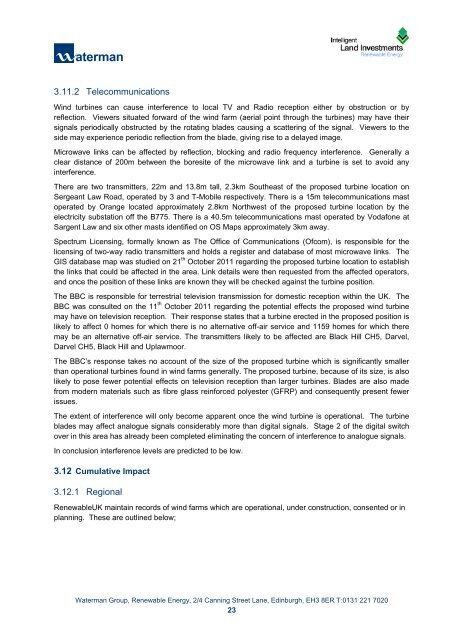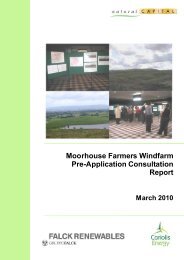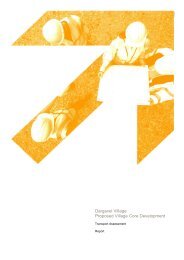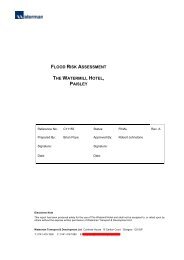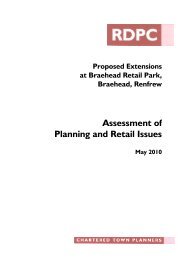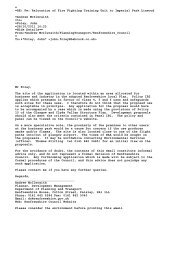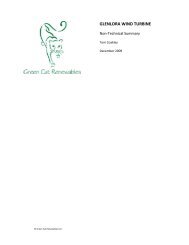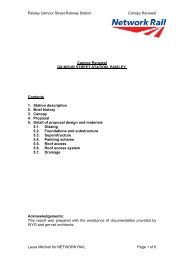Supporting Documentation - Renfrewshire Council
Supporting Documentation - Renfrewshire Council
Supporting Documentation - Renfrewshire Council
Create successful ePaper yourself
Turn your PDF publications into a flip-book with our unique Google optimized e-Paper software.
3.11.2 Telecommunications<br />
Wind turbines can cause interference to local TV and Radio reception either by obstruction or by<br />
reflection. Viewers situated forward of the wind farm (aerial point through the turbines) may have their<br />
signals periodically obstructed by the rotating blades causing a scattering of the signal. Viewers to the<br />
side may experience periodic reflection from the blade, giving rise to a delayed image.<br />
Microwave links can be affected by reflection, blocking and radio frequency interference. Generally a<br />
clear distance of 200m between the boresite of the microwave link and a turbine is set to avoid any<br />
interference.<br />
There are two transmitters, 22m and 13.8m tall, 2.3km Southeast of the proposed turbine location on<br />
Sergeant Law Road, operated by 3 and T-Mobile respectively. There is a 15m telecommunications mast<br />
operated by Orange located approximately 2.8km Northwest of the proposed turbine location by the<br />
electricity substation off the B775. There is a 40.5m telecommunications mast operated by Vodafone at<br />
Sargent Law and six other masts identified on OS Maps approximately 3km away.<br />
Spectrum Licensing, formally known as The Office of Communications (Ofcom), is responsible for the<br />
licensing of two-way radio transmitters and holds a register and database of most microwave links. The<br />
GIS database map was studied on 21 th October 2011 regarding the proposed turbine location to establish<br />
the links that could be affected in the area. Link details were then requested from the affected operators,<br />
and once the position of these links are known they will be checked against the turbine position.<br />
The BBC is responsible for terrestrial television transmission for domestic reception within the UK. The<br />
BBC was consulted on the 11 th October 2011 regarding the potential effects the proposed wind turbine<br />
may have on television reception. Their response states that a turbine erected in the proposed position is<br />
likely to affect 0 homes for which there is no alternative off-air service and 1159 homes for which there<br />
may be an alternative off-air service. The transmitters likely to be affected are Black Hill CH5, Darvel,<br />
Darvel CH5, Black Hill and Uplawmoor.<br />
The BBC’s response takes no account of the size of the proposed turbine which is significantly smaller<br />
than operational turbines found in wind farms generally. The proposed turbine, because of its size, is also<br />
likely to pose fewer potential effects on television reception than larger turbines. Blades are also made<br />
from modern materials such as fibre glass reinforced polyester (GFRP) and consequently present fewer<br />
issues.<br />
The extent of interference will only become apparent once the wind turbine is operational. The turbine<br />
blades may affect analogue signals considerably more than digital signals. Stage 2 of the digital switch<br />
over in this area has already been completed eliminating the concern of interference to analogue signals.<br />
In conclusion interference levels are predicted to be low.<br />
3.12 Cumulative Impact<br />
3.12.1 Regional<br />
RenewableUK maintain records of wind farms which are operational, under construction, consented or in<br />
planning. These are outlined below;<br />
Waterman Group, Renewable Energy, 2/4 Canning Street Lane, Edinburgh, EH3 8ER T:0131 221 7020<br />
23<br />
K:\Projects\CIV12920_ILI Windfarms_Batch 7\CIV12920_XXX_Hartfield<br />
Farm\Documents\Reports\CIV12920_1202xx_Hartfield_<strong>Supporting</strong> Turbine Assessment_225kW.docx


